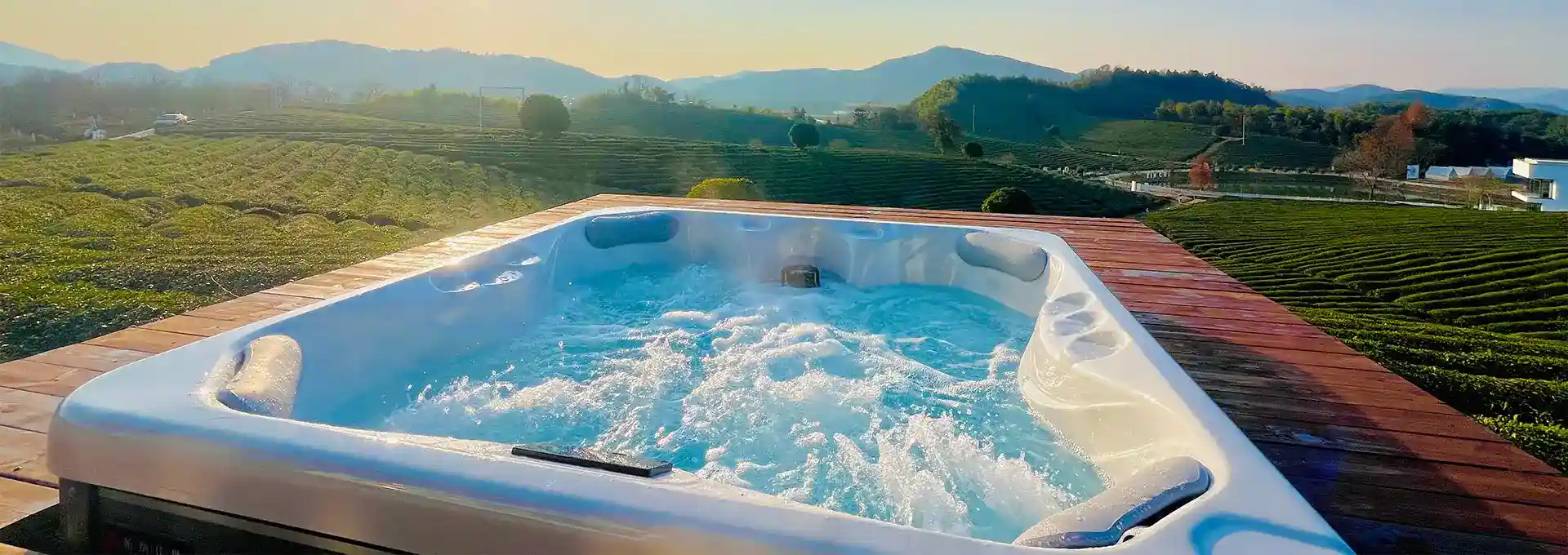How Is 7 Person Swim Spa Different From A Regular Hot Tub?
2025-02-24 14:21:07
When it comes to relaxation and hydrotherapy, both swim spas and hot tubs offer unique benefits. However, a 7 person swim spa differs significantly from a regular hot tub in several ways. Swim spas are larger, more versatile, and offer a combination of exercise and relaxation features that set them apart from traditional hot tubs. In this blog post, we'll explore the key differences between 7 person swim spas and regular hot tubs, helping you understand which option might be best for your needs.
What are the main differences in size and capacity between a swim spa and a hot tub?
One of the most noticeable differences between a 7 person swim spa and a regular hot tub is their size and capacity. Swim spas are generally much larger than hot tubs, offering more space for both swimming and relaxation. A typical 7 person swim spa can range from 12 to 19 feet in length, while a standard hot tub is usually around 7 to 8 feet in diameter.
The increased size of a swim spa allows for a more diverse range of activities. In a swim spa, you have enough space to swim laps, exercise, and enjoy hydrotherapy, all in one unit. This is possible due to the swim spa's elongated design, which typically features a swimming area on one end and a seating area on the other.
In terms of water capacity, a 7 person swim spa can hold significantly more water than a regular hot tub. While a standard hot tub might contain 300-500 gallons of water, a swim spa can hold anywhere from 1,500 to 2,500 gallons or more. This larger water volume allows for more buoyancy and resistance during swimming and exercise activities.
The increased size and capacity of a swim spa also means that it can comfortably accommodate more people. As the name suggests, a 7 person swim spa can easily fit seven adults, with room for some to swim or exercise while others relax in the seating area. In contrast, a regular hot tub typically seats 4-6 people, and everyone is confined to the same space.
However, it's important to note that the larger size of a swim spa also means it requires more space for installation. While a hot tub can often fit on a standard deck or patio, a swim spa may require a larger, reinforced area due to its size and weight when filled with water. This is an important consideration when choosing between the two options.
How do the features and functionality of a swim spa compare to those of a hot tub?
When it comes to features and functionality, 7 person swim spa and hot tubs have some similarities but also significant differences. Both offer hydrotherapy benefits through jet systems, but swim spas typically provide a wider range of features and uses.
One of the most distinctive features of a swim spa is its ability to generate a current for swimming or aquatic exercise. This is usually achieved through powerful jets or a propulsion system at one end of the spa. This feature allows users to swim in place against the current, effectively turning the swim spa into an "endless pool." This functionality is not available in regular hot tubs, which are primarily designed for stationary relaxation.
In addition to swimming, swim spas often come equipped with features that support a variety of aquatic exercises. These may include resistance bands, rowing bars, and even underwater treadmills in some high-end models. These features transform the swim spa into a comprehensive aquatic gym, offering low-impact exercise options that are particularly beneficial for those with joint issues or those recovering from injuries.
The jet systems in swim spas are also typically more varied and powerful than those in hot tubs. While hot tubs usually have jets designed primarily for massage and relaxation, swim spas often feature a combination of therapy jets and swim jets. The therapy jets are similar to those found in hot tubs, providing targeted massage to specific areas of the body. The swim jets, on the other hand, are more powerful and are used to create the current for swimming and exercise.
Temperature control is another area where swim spas and hot tubs differ. Hot tubs are typically kept at higher temperatures, usually between 100-104°F (38-40°C), which is ideal for relaxation but not suitable for extended periods of exercise. Swim spas, however, are often designed with dual-temperature zones. The swimming area is kept cooler, usually around 80-85°F (27-29°C), which is more comfortable for exercise, while the spa section can be heated to typical hot tub temperatures for relaxation.
In terms of energy efficiency, swim spas and hot tubs can vary. Due to their larger size, swim spas generally require more energy to heat and maintain temperature. However, many modern swim spas are designed with energy-efficient features such as improved insulation and smart heating systems to minimize energy consumption.
Lastly, many swim spas come with advanced control systems that allow users to adjust jet strength, temperature, and even pre-programmed workout routines. While some high-end hot tubs also offer sophisticated control systems, the range of controllable features is typically more extensive in swim spas due to their multifunctional nature.
What are the cost implications of choosing a swim spa over a traditional hot tub?
When considering the purchase of a swim spa versus a traditional hot tub, cost is often a significant factor. Generally speaking, swim spas tend to be more expensive than hot tubs due to their larger size, additional features, and more complex systems.
The initial purchase price of a 7 person swim spa can range from $20,000 to $50,000 or more, depending on the brand, model, and features. High-end models with advanced features like built-in exercise equipment or sophisticated control systems can even exceed $100,000. In contrast, a quality hot tub typically costs between $5,000 and $15,000, with luxury models potentially reaching up to $20,000 or more.
However, the cost considerations don't end with the purchase price. Installation costs can also differ significantly between swim spas and hot tubs. Due to their larger size and weight, swim spas often require more extensive site preparation. This may include reinforcing the ground, creating a larger concrete pad, or even partial in-ground installation. These additional requirements can add several thousand dollars to the overall cost. Hot tubs, being smaller and lighter, typically have lower installation costs and can often be placed on existing decks or patios with minimal preparation.
Operating costs are another factor to consider. Because of their larger water volume, swim spas generally consume more energy to heat and maintain temperature than hot tubs. However, the exact difference in energy costs can vary widely depending on factors such as local energy prices, climate, usage patterns, and the energy efficiency of the specific models being compared. Some swim spa owners report monthly energy costs of $50-$100, while hot tub energy costs typically range from $20-$50 per month.
Maintenance costs should also be factored into the overall cost comparison. Swim spas, with their larger water volume, require more chemicals and potentially more frequent water changes. They may also have more complex filtration and circulation systems that could incur higher maintenance and repair costs over time. However, many swim spa owners find that the cost per use is actually lower than a hot tub if the spa is used frequently for both exercise and relaxation.
It's important to note that while swim spas are generally more expensive, they also offer more functionality. For those who would otherwise purchase both a hot tub and a small pool or home gym equipment, a swim spa could potentially represent a cost-saving option by combining these functions into one unit.
Resale value is another consideration. While both swim spas and hot tubs can add value to a home, swim spas may have a slight edge due to their multifunctionality and appeal to health-conscious buyers. However, this can vary depending on local real estate markets and individual buyer preferences.
Lastly, financing options are available for both swim spas and hot tubs, which can help make the initial purchase more manageable. Many retailers offer payment plans or work with third-party financing companies to provide options like low-interest or deferred-interest plans.
In conclusion, while a 7 person swim spa typically represents a larger financial investment than a traditional hot tub, it also offers a broader range of features and functionalities. The decision between the two ultimately depends on individual needs, preferences, and budget considerations. Those who value the ability to exercise, swim, and relax in one unit may find the additional cost of a swim spa to be worthwhile, while those primarily interested in relaxation and hydrotherapy might prefer the lower cost and simpler maintenance of a traditional hot tub.
For more information on 7 person swim spa installations and our products, please feel free to contact us at info@iparnassus.com.
References
- Swim University. "Swim Spa vs. Hot Tub: Which One is Right for You?"
- Master Spas. "Swim Spa vs. Hot Tub: Which is Better?"
- Aqua Magazine. "Swim Spas: The Best of Both Worlds"
- Hot Spring Spas. "Hot Tub vs. Swim Spa: Which One is Right for You?"
- Hydropool. "Swim Spas vs. Hot Tubs: What's the Difference?"
- SwimEx. "Swim Spa vs. Hot Tub: Which is Right for You?"
- Home Stratosphere. "Hot Tub vs. Swim Spa (Differences & Similarities)"
- Bullfrog Spas. "Hot Tub vs. Swim Spa: How to Choose"
- Splash Magazine. "The Differences Between Swim Spas and Hot Tubs"
- Pool and Spa News. "Swim Spas: A Growing Niche in the Pool and Spa Industry"



